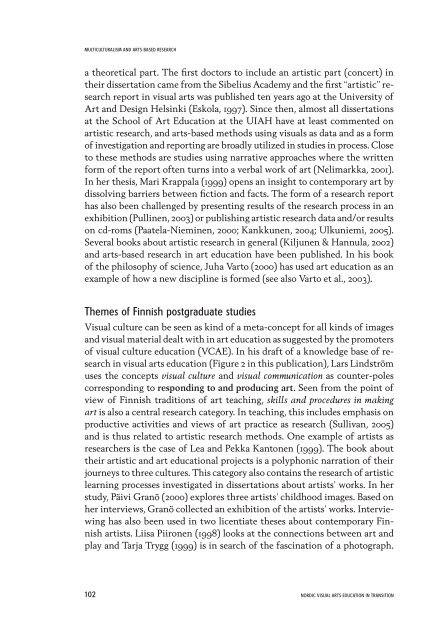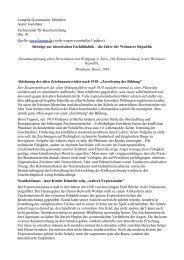Research in Visual Arts Education - The National Society for ...
Research in Visual Arts Education - The National Society for ...
Research in Visual Arts Education - The National Society for ...
You also want an ePaper? Increase the reach of your titles
YUMPU automatically turns print PDFs into web optimized ePapers that Google loves.
MULTICULTURALISM AND ARTS-BASED RESEARCH<br />
a theoretical part. <strong>The</strong> first doctors to <strong>in</strong>clude an artistic part (concert) <strong>in</strong><br />
their dissertation came from the Sibelius Academy and the first “artistic” research<br />
report <strong>in</strong> visual arts was published ten years ago at the University of<br />
Art and Design Hels<strong>in</strong>ki (Eskola, 1997). S<strong>in</strong>ce then, almost all dissertations<br />
at the School of Art <strong>Education</strong> at the UIAH have at least commented on<br />
artistic research, and arts-based methods us<strong>in</strong>g visuals as data and as a <strong>for</strong>m<br />
of <strong>in</strong>vestigation and report<strong>in</strong>g are broadly utilized <strong>in</strong> studies <strong>in</strong> process. Close<br />
to these methods are studies us<strong>in</strong>g narrative approaches where the written<br />
<strong>for</strong>m of the report often turns <strong>in</strong>to a verbal work of art (Nelimarkka, 2001).<br />
In her thesis, Mari Krappala (1999) opens an <strong>in</strong>sight to contemporary art by<br />
dissolv<strong>in</strong>g barriers between fiction and facts. <strong>The</strong> <strong>for</strong>m of a research report<br />
has also been challenged by present<strong>in</strong>g results of the research process <strong>in</strong> an<br />
exhibition (Pull<strong>in</strong>en, 2003) or publish<strong>in</strong>g artistic research data and/or results<br />
on cd-roms (Paatela-Niem<strong>in</strong>en, 2000; Kankkunen, 2004; Ulkuniemi, 2005).<br />
Several books about artistic research <strong>in</strong> general (Kiljunen & Hannula, 2002)<br />
and arts-based research <strong>in</strong> art education have been published. In his book<br />
of the philosophy of science, Juha Varto (2000) has used art education as an<br />
example of how a new discipl<strong>in</strong>e is <strong>for</strong>med (see also Varto et al., 2003).<br />
<strong>The</strong>mes of F<strong>in</strong>nish postgraduate studies<br />
<strong>Visual</strong> culture can be seen as k<strong>in</strong>d of a meta-concept <strong>for</strong> all k<strong>in</strong>ds of images<br />
and visual material dealt with <strong>in</strong> art education as suggested by the promoters<br />
of visual culture education (VCAE). In his draft of a knowledge base of research<br />
<strong>in</strong> visual arts education (Figure 2 <strong>in</strong> this publication), Lars L<strong>in</strong>dström<br />
uses the concepts visual culture and visual communication as counter-poles<br />
correspond<strong>in</strong>g to respond<strong>in</strong>g to and produc<strong>in</strong>g art. Seen from the po<strong>in</strong>t of<br />
view of F<strong>in</strong>nish traditions of art teach<strong>in</strong>g, skills and procedures <strong>in</strong> mak<strong>in</strong>g<br />
art is also a central research category. In teach<strong>in</strong>g, this <strong>in</strong>cludes emphasis on<br />
productive activities and views of art practice as research (Sullivan, 2005)<br />
and is thus related to artistic research methods. One example of artists as<br />
researchers is the case of Lea and Pekka Kantonen (1999). <strong>The</strong> book about<br />
their artistic and art educational projects is a polyphonic narration of their<br />
journeys to three cultures. This category also conta<strong>in</strong>s the research of artistic<br />
learn<strong>in</strong>g processes <strong>in</strong>vestigated <strong>in</strong> dissertations about artists’ works. In her<br />
study, Päivi Granö (2000) explores three artists’ childhood images. Based on<br />
her <strong>in</strong>terviews, Granö collected an exhibition of the artists’ works. Interview<strong>in</strong>g<br />
has also been used <strong>in</strong> two licentiate theses about contemporary F<strong>in</strong>nish<br />
artists. Liisa Piironen (1998) looks at the connections between art and<br />
play and Tarja Trygg (1999) is <strong>in</strong> search of the fasc<strong>in</strong>ation of a photograph.<br />
102 NORDIC VISUAL ARTS EDUCATION IN TRANSITION



